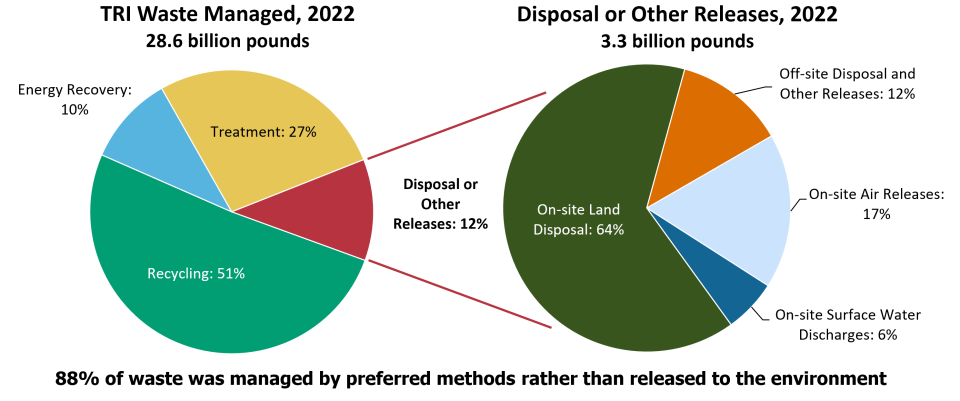Introduction to the 2022 TRI National Analysis
Under Section 313 of the Emergency Planning and Community Right-to-Know Act (EPCRA) and Section 6607 of the Pollution Prevention Act (PPA), facilities that meet TRI reporting requirements must report details about their pollution prevention and waste management activities—including releases—of TRI-listed chemicals that occurred during the calendar year by July 1 of the following year.
Watch a short video about the TRI National Analysis report.
Industries and businesses in the U.S. use many chemicals to make the products we depend on, such as pharmaceuticals, computers, paints, clothing, and automobiles. While most chemicals on the Toxics Release Inventory (TRI) chemical list are managed by facilities in ways that minimize releases into the environment, releases still occur as part of normal business operations.
It is your right to know what TRI chemicals are being used in your community, how the chemical waste is managed—including through environmental releases—and whether these quantities have changed over time.
The TRI tracks how industries manage certain toxic chemicals. Information facilities report each year to EPA provides insights into how chemicals are managed by facilities conducting industrial activities such as manufacturing, metal mining, generation of electric power, and hazardous waste management. TRI data are publicly available. For calendar year 2022, more than 21,000 facilities reported to the TRI Program.
Each year, in support of its mission to protect human health and the environment, EPA analyzes the most recent TRI data, conducts comparative analyses with TRI data for previous years, and publishes its findings in the TRI National Analysis. Check out the Catalog of Applied TRI Data Uses to learn more about how EPA and others have used TRI data.
Overview of the 2022 TRI data
The two pie charts below summarize the most recent TRI data: the chart on the left shows the total amount of TRI chemical waste managed through recycling, energy recovery, treatment, and disposal or other releases. The chart on the right shows the proportions of TRI chemical waste released to air, water, and land, and transferred off site for disposal.

Note: 1) Percentages do not sum to 100% due to rounding. 2) To avoid double counting, the Disposal or Other Releases pie chart on the right excludes quantities of TRI chemicals that are transferred off site from a TRI-reporting facility and subsequently released on site by a receiving facility that also reports to TRI.
- Facilities reported managing 28.6 billion pounds of TRI-listed chemicals as waste during 2022. Waste managed is the quantity of TRI chemicals in waste resulting from routine operations. Facilities manage this waste through recycling, combustion for energy recovery, treatment, and disposing of or otherwise releasing the waste into the environment.
- Of this total, 88% was recycled, combusted for energy recovery, or treated, while 12% was disposed of or otherwise released into the environment.
- For TRI chemicals in waste that were disposed of or otherwise released, facilities report the quantities of these releases and whether the releases were to the air, water, or land. Most releases of TRI chemicals occur on site at facilities. However, waste containing TRI chemicals may also be shipped off site for disposal, such as to a landfill. As shown in the pie chart on the right, most TRI chemical waste was disposed of to land, which includes landfills, underground injection, and other land disposal practices.
What’s new in TRI for 2022?
- The TRI Program expanded coverage of the natural gas processing sector to include all natural gas processing facilities that receive and refine natural gas. In prior years, only natural gas processing facilities that primarily recovered sulfur from natural gas were required to report. For 2022, 305 facilities in the sector reported managing 115 million pounds of TRI chemicals as waste, most of which (89 million pounds) were released.
- EPA extended TRI reporting requirements to cover certain contract sterilization facilities that use ethylene oxide. These facilities collectively reported releasing 9,166 pounds of ethylene oxide into the air in 2022.
- Four per- and polyfluoroalkyl substances (PFAS) were added to the TRI chemical list. To learn more, see the PFAS Chemical Profile.
- For the complete list of changes to the TRI reporting requirements for 2022, see the 2022 TRI Reporting Forms and Instructions (pdf).
Where are the Facilities that Reported to TRI for 2022 Located?
Click on any of the locations to see a facility’s TRI information.
View Larger Map
This page was published in March 2024 and uses the 2022 TRI National Analysis dataset made public in TRI Explorer in October 2023.
